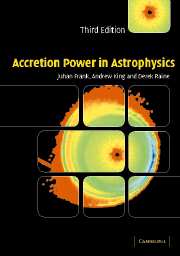Book contents
- Frontmatter
- Contents
- Preface to the first edition
- Preface to the second edition
- Preface to the third edition
- 1 ACCRETION AS A SOURCE OF ENERGY
- 2 GAS DYNAMICS
- 3 PLASMA CONCEPTS
- 4 ACCRETION IN BINARY SYSTEMS
- 5 ACCRETION DISCS
- 6 ACCRETION ON TO A COMPACT OBJECT
- 7 ACTIVE GALACTIC NUCLEI
- 8 ACCRETION DISCS IN ACTIVE GALACTIC NUCLEI
- 9 ACCRETION POWER IN ACTIVE GALACTIC NUCLEI
- 10 THICK DISCS
- 11 ACCRETION FLOWS
- Appendix: Radiation processes
- Problems
- Bibliography
- Index
Preface to the second edition
Published online by Cambridge University Press: 05 June 2012
- Frontmatter
- Contents
- Preface to the first edition
- Preface to the second edition
- Preface to the third edition
- 1 ACCRETION AS A SOURCE OF ENERGY
- 2 GAS DYNAMICS
- 3 PLASMA CONCEPTS
- 4 ACCRETION IN BINARY SYSTEMS
- 5 ACCRETION DISCS
- 6 ACCRETION ON TO A COMPACT OBJECT
- 7 ACTIVE GALACTIC NUCLEI
- 8 ACCRETION DISCS IN ACTIVE GALACTIC NUCLEI
- 9 ACCRETION POWER IN ACTIVE GALACTIC NUCLEI
- 10 THICK DISCS
- 11 ACCRETION FLOWS
- Appendix: Radiation processes
- Problems
- Bibliography
- Index
Summary
In the years since the first edition of this book appeared the study of astrophysical accretion has developed rapidly. Perhaps the most fundamental change has been the shift in attitude over active galaxies and quasars: the view that accretion is the energy source is now effectively standard, and the emphasis is much more on close comparison of observation and theory. This change, and the less spectacular but still profound one which has occurred in the study of close binary accretion, have been largely brought about by the wealth of new data accumulated in the interval. In X-rays, the ability of EXOSAT to observe continuously for as much as 3 to 4 days was a dramatic advance. In the optical, new instrumentation has produced far tighter observational constraints on theory. Despite these challenges, the basic outlines of the theory are still recognizably the same.
Of course our understanding is very incomplete. As the most glaring example, we still have essentially no idea what drives disc accretion; and there are new problems such as the dynamical stability of thick discs, or the nature of fieldline threading in magnetic binaries. But it is now difficult to deny that some close binaries possess discs approximately conforming to theoretical ideas; or that some kind of anisotropic accretion occurs in active galactic nuclei. Encouragingly, accretion theory is increasingly integrated into wider pictures of the relevant systems. The process is well advanced for close binaries, particularly for the secular evolution of cataclysmic variables, and is in its early stages for active galaxies.
- Type
- Chapter
- Information
- Accretion Power in Astrophysics , pp. xi - xiiPublisher: Cambridge University PressPrint publication year: 2002



